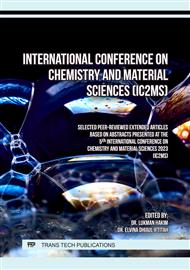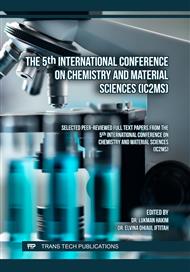[1]
A. Pawełczyk, K. Sowa-Kasprzak, D. Olender, L. Zaprutko, "Molecular Consortia—Various Structural and Synthetic Concepts for More Effective Therapeutics Synthesis," IJMS, vol. 19, no. 4 (2018), p.1104.
DOI: 10.3390/ijms19041104
Google Scholar
[2]
E. Proschak, H. Stark, D. Merk, "Polypharmacology by Design: A Medicinal Chemist's Perspective on Multitargeting Compounds," J. Med. Chem., vol. 62, no. 2 (2019), pp.420-444.
DOI: 10.1021/acs.jmedchem.8b00760
Google Scholar
[3]
R. Ribeiro-Santos, M. Andrade, A. Sanches-Silva, N. R. de Melo, "Essential Oils for Food Application: Natural Substances with Established Biological Activities," Food Bioprocess Technol, vol. 11, no. 1 (2018), p.43–71.
DOI: 10.1007/s11947-017-1948-6
Google Scholar
[4]
R. Dachineni et al., "Salicylic acid metabolites and derivatives inhibit CDK activity: Novel insights into aspirin's chemopreventive effects against colorectal cancer," Int J Oncol, vol. 51, no. 6 (2017), p.1661–1673.
DOI: 10.3892/ijo.2017.4167
Google Scholar
[5]
H. Sidhu, N. Capalash, "Synergistic anti-cancer action of salicylic acid and cisplatin on HeLa cells elucidated by network pharmacology and in vitro analysis," Life Sciences, vol. 282 (2021), p.119802.
DOI: 10.1016/j.lfs.2021.119802
Google Scholar
[6]
L. Pinzi, G. Rastelli, "Molecular Docking: Shifting Paradigms in Drug Discovery," Int J Mol Sci, vol. 20, no. 18 (2019), p.4331.
DOI: 10.3390/ijms20184331
Google Scholar
[7]
J.E. Rundhaug, "Matrix metalloproteinases, angiogenesis, and cancer: commentary re: A. C. Lockhart et al., Reduction of wound angiogenesis in patients treated with BMS-275291, a broad spectrum matrix metalloproteinase inhibitor. Clin Cancer Res, vol. 9, no. 2 (2003), p.551–554.
Google Scholar
[8]
A.Misko, T.Ferguson, L. Notterpek, "Matrix metalloproteinase mediated degradation of basement membrane proteins in Trembler J neuropathy nerves," Journal of Neurochemistry, vol. 83, no. 4 (2002), p.885–894.
DOI: 10.1046/j.1471-4159.2002.01200.x
Google Scholar
[9]
Y. Yarden, M. X. Sliwkowski, "Untangling the ErbB signalling network," Nat Rev Mol Cell Biol, vol. 2, no. 2 (2001), p.127–137.
DOI: 10.1038/35052073
Google Scholar
[10]
J. Schlessinger, "Common and distinct elements in cellular signaling via EGF and FGF receptors," Science, vol. 306, no. 5701 (2004), p.1506–1507.
DOI: 10.1126/science.1105396
Google Scholar
[11]
J.C. Morales et al., "Review of Poly (ADP-ribose) Polymerase (PARP) Mechanisms of Action and Rationale for Targeting in Cancer and Other Diseases," Crit Rev Eukaryot Gene Expr, vol. 24, no. 1 (2014), p.15–28.
DOI: 10.1615/critreveukaryotgeneexpr.2013006875
Google Scholar
[12]
A. J. Wiggans, G. K. Cass, A. Bryant, T. A. Lawrie, J. Morrison, "Poly(ADP‐ribose) polymerase (PARP) inhibitors for the treatment of ovarian cancer," Cochrane Database Syst Rev, vol. 2015, no. 5 (2015), p. CD007929.
DOI: 10.1002/14651858.cd007929.pub3
Google Scholar
[13]
N. Vale, A. Ferreira, J. Matos, P. Fresco, M.J. Gouveia, "Amino Acids in the Development of Prodrugs," Molecules, vol. 23, no. 9 (2018), p.2318.
DOI: 10.3390/molecules23092318
Google Scholar
[14]
Q. Xu, H. Deng, X. Li, Z.-S. Quan, "Application of Amino Acids in the Structural Modification of Natural Products: A Review," Frontiers in Chemistry, vol. 9 (2021), Accessed: Nov. 05, 2023. [Online]. Available: https://www.frontiersin.org/articles/.
DOI: 10.3389/fchem.2021.650569
Google Scholar



